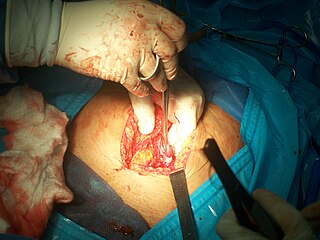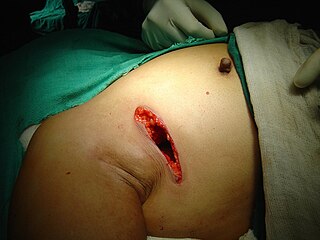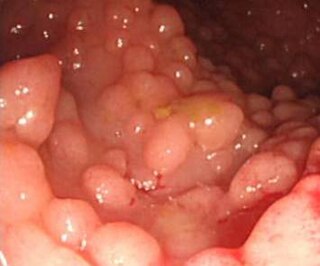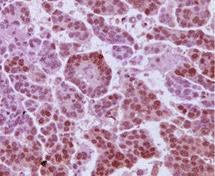Related Research Articles

Mastectomy is the medical term for the surgical removal of one or both breasts, partially or completely. A mastectomy is usually carried out to treat breast cancer. In some cases, women believed to be at high risk of breast cancer have the operation as a preventive measure. Alternatively, some women can choose to have a wide local excision, also known as a lumpectomy, an operation in which a small volume of breast tissue containing the tumor and a surrounding margin of healthy tissue is removed to conserve the breast. Both mastectomy and lumpectomy are referred to as "local therapies" for breast cancer, targeting the area of the tumor, as opposed to systemic therapies, such as chemotherapy, hormonal therapy, or immunotherapy.

Tubal ligation is a surgical procedure for female sterilization in which the fallopian tubes are permanently blocked, clipped or removed. This prevents the fertilization of eggs by sperm and thus the implantation of a fertilized egg. Tubal ligation is considered a permanent method of sterilization and birth control.

Breast cancer is cancer that develops from breast tissue. Signs of breast cancer may include a lump in the breast, a change in breast shape, dimpling of the skin, milk rejection, fluid coming from the nipple, a newly inverted nipple, or a red or scaly patch of skin. In those with distant spread of the disease, there may be bone pain, swollen lymph nodes, shortness of breath, or yellow skin.

Mammaplasty refers to a group of surgical procedures, the goal of which is to reshape or otherwise modify the appearance of the breast. There are two main types of mammoplasty:
- Augmentation mammaplasty is commonly performed to increase the size, change the shape, and/or alter the texture of the breasts. This usually involves the surgical implantation of breast implant devices.
- Reduction mammaplasty is commonly performed to reduce the size, change the shape, and/or alter the texture of the breasts. This involves the removal of breast tissue.

Hysterectomy is the surgical removal of the uterus and cervix. Supracervical hysterectomy refers to removal of the uterus while the cervix is spared. These procedures may also involve removal of the ovaries (oophorectomy), fallopian tubes (salpingectomy), and other surrounding structures. The term “partial” or “total” hysterectomy are lay-terms that incorrectly describe the addition or omission of oophorectomy at the time of hysterectomy. These procedures are usually performed by a gynecologist. Removal of the uterus renders the patient unable to bear children and has surgical risks as well as long-term effects, so the surgery is normally recommended only when other treatment options are not available or have failed. It is the second most commonly performed gynecological surgical procedure, after cesarean section, in the United States. Nearly 68 percent were performed for conditions such as endometriosis, irregular bleeding, and uterine fibroids. It is expected that the frequency of hysterectomies for non-malignant indications will continue to fall given the development of alternative treatment options.
Oophorectomy, historically also called ovariotomy is the surgical removal of an ovary or ovaries. The surgery is also called ovariectomy, but this term is mostly used in reference to animals, e.g. the surgical removal of ovaries from laboratory animals. Removal of the ovaries of females is the biological equivalent of castration of males; the term castration is only occasionally used in the medical literature to refer to oophorectomy of women. In veterinary medicine, the removal of ovaries and uterus is called ovariohysterectomy (spaying) and is a form of sterilization.

Ovarian cancer is a cancerous tumor of an ovary. It may originate from the ovary itself or more commonly from communicating nearby structures such as fallopian tubes or the inner lining of the abdomen. The ovary is made up of three different cell types including epithelial cells, germ cells, and stromal cells. When these cells become abnormal, they have the ability to divide and form tumors. These cells can also invade or spread to other parts of the body. When this process begins, there may be no or only vague symptoms. Symptoms become more noticeable as the cancer progresses. These symptoms may include bloating, vaginal bleeding, pelvic pain, abdominal swelling, constipation, and loss of appetite, among others. Common areas to which the cancer may spread include the lining of the abdomen, lymph nodes, lungs, and liver.
Gender-affirming surgery for female-to-male transgender people includes a variety of surgical procedures that alter anatomical traits to provide physical traits more comfortable to the trans man's male identity and functioning.

Salpingectomy refers to the surgical removal of a fallopian tube. This may be done to treat an ectopic pregnancy or cancer, to prevent cancer, or as a form of contraception.

Hereditary breast–ovarian cancer syndromes (HBOC) are cancer syndromes that produce higher than normal levels of breast cancer, ovarian cancer and additional cancers in genetically related families. It accounts for 90% of the hereditary cancers. The hereditary factors may be proven or suspected to cause the pattern of breast and ovarian cancer occurrences in the family. The name HBOC may be misleading because it implies that this genetic susceptibility to cancer is mainly in women. In reality, both sexes have the same rates of gene mutations and HBOC can predispose to other cancers including prostate cancer and pancreatic cancer. For this reason, the term "King syndrome" has recently come into use. The new name references Mary-Claire King who identified the genes BRCA1 and BRCA2.

Breast-conserving surgery refers to an operation that aims to remove breast cancer while avoiding a mastectomy. Different forms of this operation include: lumpectomy (tylectomy), wide local excision, segmental resection, and quadrantectomy. Breast-conserving surgery has been increasingly accepted as an alternative to mastectomy in specific patients, as it provides tumor removal while maintaining an acceptable cosmetic outcome. This page reviews the history of this operation, important considerations in decision making and patient selection, and the emerging field of oncoplastic breast conservation surgery.

Male breast cancer (MBC) is a cancer in males that originates in their breasts. Males account for less than 1% of new breast cancers with about 20,000 new cases being diagnosed worldwide every year. Its incidence rates in males vs. females are, respectively, 0.4 and 66.7 per 100,000 person-years. The worldwide incidences of male as well as female breast cancers have been increasing over the last few decades. Currently, one of every 800 men are estimated to develop this cancer during their lifetimes.

A BRCA mutation is a mutation in either of the BRCA1 and BRCA2 genes, which are tumour suppressor genes. Hundreds of different types of mutations in these genes have been identified, some of which have been determined to be harmful, while others have no proven impact. Harmful mutations in these genes may produce a hereditary breast–ovarian cancer syndrome in affected persons. Only 5–10% of breast cancer cases in women are attributed to BRCA1 and BRCA2 mutations, but the impact on women with the gene mutation is more profound. Women with harmful mutations in either BRCA1 or BRCA2 have a risk of breast cancer that is about five times the normal risk, and a risk of ovarian cancer that is about ten to thirty times normal. The risk of breast and ovarian cancer is higher for women with a high-risk BRCA1 mutation than with a BRCA2 mutation. Having a high-risk mutation does not guarantee that the woman will develop any type of cancer, or imply that any cancer that appears was actually caused by the mutation, rather than some other factor.

A hereditary cancer syndrome is a genetic disorder in which inherited genetic mutations in one or more genes predispose the affected individuals to the development of cancer and may also cause early onset of these cancers. Hereditary cancer syndromes often show not only a high lifetime risk of developing cancer, but also the development of multiple independent primary tumors.
A preventive mastectomy or prophylactic mastectomy or risk-reducing mastectomy (RRM) is an elective operation to remove the breasts so that the risk of breast cancer is reduced.

High-grade serous carcinoma (HGSC) is a type of tumour that arises from the serous epithelial layer in the abdominopelvic cavity and is mainly found in the ovary. HGSCs make up the majority of ovarian cancer cases and have the lowest survival rates. HGSC is distinct from low-grade serous carcinoma (LGSC) which arises from ovarian tissue, is less aggressive and is present in stage I ovarian cancer where tumours are localised to the ovary.

Prophylactic salpingectomy is a preventative surgical technique performed on patients who are at higher risk of having ovarian cancer, such as individuals who may have pathogenic variants of the BRCA1 or BRCA2 gene. Originally salpingectomy was used in cases of ectopic pregnancies. As a preventative surgery however, it involves the removal of the fallopian tubes. By not removing the ovaries this procedure is advantageous to individuals who are still of child bearing age. It also reduces risks such as cardiovascular disease and osteoporosis which are associated with removal of the ovaries.

Breast and ovarian cancer does not necessarily imply that both cancers occur at the same time, but rather that getting one cancer would lead to the development of the other within a few years. Women with a history of breast cancer have a higher chance of developing ovarian cancer, vice versa.

The SEE-FIM protocol is a pathology dissection protocol for Sectioning and Extensively Examining the Fimbria (SEE-FIM). This protocol is intended to provide for the optimal microscopic examination of the distal fallopian tube (fimbria) to identify either cancerous or precancerous conditions in this organ.
References
- ↑ "NCI Dictionary of Cancer Terms". National Cancer Institute. National Cancer Institute. 2011-02-02. Retrieved 2019-06-20.
- ↑ Mau, C.; Untch, M. (2017). "Prophylactic Surgery: For Whom, When and How?". Breast Care (Basel, Switzerland). 12 (6): 379–384. doi:10.1159/000485830. PMC 5803721 . PMID 29456469.
- 1 2 U.S. Department of Health and Human Services, National Institutes of Health. "NCI Dictionary of Cancer Terms". National Cancer Institute. Retrieved 17 May 2019.
- 1 2 3 Australian Government, Cancer Australia (2019). "Prophylactic surgery". EdCaN. Retrieved 17 May 2019.
- 1 2 C. Shiel Jr., William. "Medical Definition of Prophylactic". MedicineNet. Retrieved 17 May 2019.
- 1 2 Howe, R. S. Van; Svoboda, J. S.; Hodges, F. M. (1 February 2002). "Prophylactic interventions on children: balancing human rights with public health". Journal of Medical Ethics. 28 (1): 10–16. doi:10.1136/jme.28.1.10. ISSN 0306-6800. PMC 1733522 . PMID 11834752.
- ↑ "Preventive medicine". Encyclopedia Britannica. Retrieved 2019-05-31.
- ↑ Moscucci, Ornella; Clarke, Aileen (March 2007). "Prophylactic oophorectomy: a historical perspective". Journal of Epidemiology and Community Health. 61 (3): 182–184. doi:10.1136/jech.2006.046474. ISSN 0143-005X. PMC 2652903 . PMID 17325391.
- ↑ "History of Surgery". Hartford Stage. Retrieved 2019-05-31.
- ↑ "Prophylactic Mastectomy Risks". Breastcancer.org. Retrieved 2019-05-31.
- 1 2 U.S. Department of Health and Human Services, National Institutes of health. "Surgery as a Preventive measure". National Cancer Institute. Retrieved 17 May 2019.
- ↑ "Primary, secondary and tertiary prevention | Institute for Work & Health". www.iwh.on.ca. Retrieved 2019-05-31.
- ↑ Untch, Michael; Mau, Christine (2017). "Prophylactic Surgery: For Whom, When and How". Breast Care. 12 (6): 379–384. doi:10.1159/000485830. ISSN 1661-3791. PMC 5803721 . PMID 29456469.
- ↑ "Genetics". National Cancer Institute. 2015-04-22. Retrieved 2019-05-17.
- ↑ Barton, Mary B.; West, Carmen N.; Liu, In-Lu A.; Harris, Emily L.; Rolnick, Sharon J.; Elmore, Joann G.; Herrinton, Lisa J.; Greene, Sarah M.; Nekhlyudov, Larissa (2005). "Complications following bilateral prophylactic mastectomy". Journal of the National Cancer Institute. Monographs. 2005 (35): 61–66. doi: 10.1093/jncimonographs/lgi039 . ISSN 1052-6773. PMID 16287887.
- ↑ Anggraeni, Tricia Dewi; Al Fattah, Adly Nanda; Surya, Raymond (2018). "Prophylactic salpingectomy and ovarian cancer: An evidence-based analysis". South Asian Journal of Cancer. 7 (1): 42–45. doi: 10.4103/sajc.sajc_187_17 . ISSN 2278-330X. PMC 5865096 . PMID 29600234.
- 1 2 Obermair, Andreas; Youlden, Danny R.; Baade, Peter D.; Janda, Monika (2014-05-01). "The impact of risk-reducing hysterectomy and bilateral salpingo-oophorectomy on survival in patients with a history of breast cancer--a population-based data linkage study" (PDF). International Journal of Cancer. 134 (9): 2211–2222. doi: 10.1002/ijc.28537 . ISSN 1097-0215. PMID 24127248.
- ↑ "Prophylactic oophorectomy: Preventing cancer by surgically removing your ovaries". Mayo Clinic. Retrieved 2019-05-17.
- ↑ Moscucci, Ornella; Clarke, Aileen (March 2007). "Prophylactic oophorectomy: a historical perspective". Journal of Epidemiology & Community Health. 61 (3): 182–184. doi:10.1136/jech.2006.046474. PMC 2652903 . PMID 17325391.
- ↑ Church, James M.; Kalady, Matthew F. (2015-01-01). "Prophylactic colectomy: Rationale, indications, and approach". Journal of Surgical Oncology. 111 (1): 112–117. doi:10.1002/jso.23820. ISSN 1096-9098. PMID 25418116. S2CID 30857701.
- ↑ Church, J. M. (December 1996). "Prophylactic colectomy in patients with hereditary nonpolyposis colorectal cancer". Annals of Medicine. 28 (6): 479–482. doi:10.3109/07853899608999111. ISSN 0785-3890. PMID 9017106.
- ↑ Church, J. M.; Fazio, V. W.; Lavery, I. C.; Oakley, J. R.; Milsom, J.; McGannon, E. (December 1996). "Quality of life after prophylactic colectomy and ileorectal anastomosis in patients with familial adenomatous polyposis". Diseases of the Colon and Rectum. 39 (12): 1404–1408. doi:10.1007/bf02054529. ISSN 0012-3706. PMID 8969666. S2CID 21382699.
- ↑ Kersting, Sabine; Dimasis, Periklis; Wiesmann, Siri; Mittelkötter, Ulrich (December 2017). "[Prophylactic Appendectomy: Yes or No?]". Zentralblatt für Chirurgie. 142 (6): 607–613. doi:10.1055/s-0043-118126. ISSN 1438-9592. PMID 28985640.
- ↑ Newhall, Karina; Albright, Benjamin; Tosteson, Anna; Ozanne, Elissa; Trus, Thadeus; Goodney, Philip P. (September 2017). "Cost-effectiveness of prophylactic appendectomy: a Markov model". Surgical Endoscopy. 31 (9): 3596–3604. doi:10.1007/s00464-016-5391-y. ISSN 1432-2218. PMID 28078461. S2CID 19060761.
- ↑ Dilek, O. N.; Güler, O.; Güler, A. A.; Demirtas, I.; Altindis, M.; Dilek, F. H.; Ozgören, E. (March 2001). "Prophylactic appendectomy: is it worth to be done?". Acta Chirurgica Belgica. 101 (2): 65–67. doi:10.1080/00015458.2001.12098588. ISSN 0001-5458. PMID 11396053. S2CID 28538790.